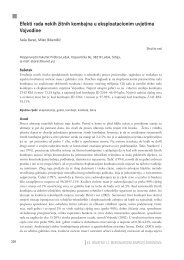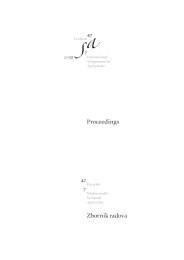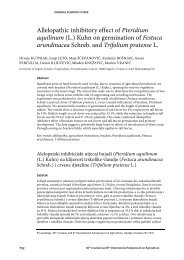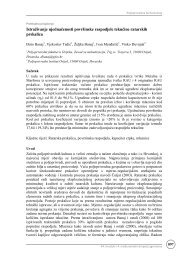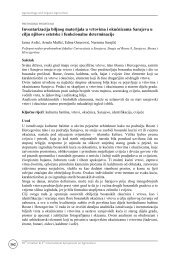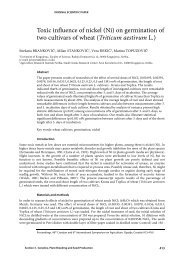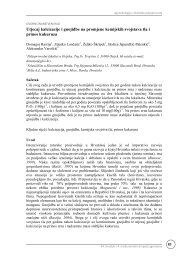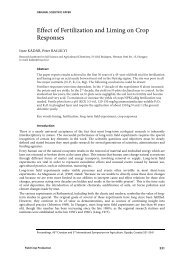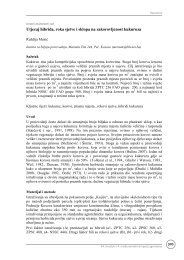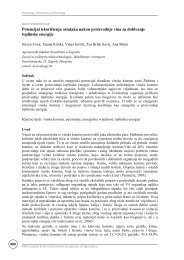SA2010 Paper Template - hr
SA2010 Paper Template - hr
SA2010 Paper Template - hr
You also want an ePaper? Increase the reach of your titles
YUMPU automatically turns print PDFs into web optimized ePapers that Google loves.
550<br />
Vegetable Growing<br />
Land preparation included autumn deep ploughing and spring harrowing. Basic<br />
fertilization was accomplished in autumn, using organic manure (30 t·ha -1 of decomposed<br />
manure incorporated by ploughing).<br />
Field crops were established by planting the seedlings cultivated in pots in greenhouses, in<br />
t<strong>hr</strong>ee different periods: first ten days of May, second ten days of May and first ten days of<br />
June. Planting was manual with 40-45 days old seedlings and with 4-5 well formed leaves,<br />
obtaining a density of 14286 plants/ha. For supporting the plant, during vegetation a 2,2 m<br />
tall trellis was used.<br />
At planting moment a starter fertilization was applied using a dose of 300 kg·ha -1 Cropcare<br />
3 fertilizer. During cultivation period various fertilization technologies were applied:<br />
Cropcare 3 starter fertilization, Cropcare 3 starter fertilization + Volldunger Linz Classic<br />
0,3% foliar fertilization, Cropcare 3 starter fertilization + Agriplant 2 0,6% foliar<br />
fertilization, Cropcare 3 starter fertilization + water diluted 1:20 Nettle macerate foliar<br />
fertilization. Application interval for all foliar fertilizations was 10-14 days.<br />
Cropcare 3 or Cropcare 10-10-20 is a complex mineral chlorineless fertilizer recommended<br />
both in starter and phasial fertilizations, especially for chlorine sensible, planted crops. Its<br />
chemical composition (%) is: N-10; P2O5-10; K2O-20; CaO-4; MgO-4; S-11; B-0,15; Cu-<br />
0,1; Fe-0,1; Mn-0,7; Mo-0,01; Zn-0,1. Volldunger Linz Classic is an water soluble<br />
complex microelements fertilizer with following composition (%): N-14; P2O5-7; K2O-21;<br />
MgO-1; microelements (B, Cu, Fe, Mn, Zn)-1. Agriplant 2 or Agriplant 12-5-24 is also an<br />
water soluble complex microelements fertilizer, used both for fertirrigation and foliar<br />
nutrition: N-12; P2O5-5; K2O-24; MgO-2; B-0,01; Cu-0,01; Fe-0,05; Mn-0,05; Mo-0,001;<br />
Zn-0,01 (%). Nettle macerate was prepared as follows: plants were cut before flowering<br />
stage and water soaked (10 l water per 1 kg of nettle), letting the pot in the sun for 12-14<br />
days and shaking solution in the morning and in the evening, for first t<strong>hr</strong>ee days; after<br />
filtering, obtained macerate was 1:20 water diluted and used for foliar nutrition.<br />
Bifactorial experiment was 3 x 5 type with 15 variants. Experimental factors presented the<br />
following graduations: A factor – planting moment – a1 May1-3th, a2 May 18-20th and a3<br />
June 4-6th; B factor – applied fertilization – b1 unfertilized, b2 Cropcare 3 starter<br />
fertilization, b3 Cropcare 3 starter fertilization + Volldunger Linz Classic 0,3% foliar<br />
fertilization, b4 Cropcare 3 starter fertilization + Agriplant 2 0,6% foliar fertilization, b5<br />
Cropcare 3 starter fertilization + water diluted 1:20 Nettle macerate foliar fertilization.<br />
Experiment was placed in belts arranged subdivided plots, for the 15 variants being<br />
performed t<strong>hr</strong>ee randomized repetitions.<br />
For experimental data processing and interpretation it was used Analysis of Variance<br />
(ANOVA) statistical method (Saulescu and Saulescu, 1967). The significance of individual<br />
differences related with control values was determined using least significant difference<br />
(LSD) procedure and represented as follows: * - significant positive, ** - highly significant<br />
positive, *** - very highly significant positive and o-significant negative, oo - highly<br />
significant negative, ooo - very highly significant negative, respectively.<br />
Results and discussion<br />
Analyzing obtained yields, as an average for 2007 and 2008 experimental years (Graph 1),<br />
one can observe that the yield of bitter gourd fruit were influenced both of fertilization<br />
technology and planting moment.<br />
Analyzing the influence of planting moment on fruit yield (Table 1), very highly<br />
significant results were determined by planting the seedling, both in the first ten days of<br />
May and in the second ten days of May, yield benefits relative to control Wt 1 (first ten<br />
days of June planting moment) being of 11,90 t·ha -1 and 7,51 t·ha -1 , respectively.<br />
45 th Croatian & 5 th International Symposium on Agriculture



